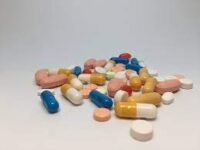Picture this: You have gotten sick from COVID-19 before. So much so, your family is worried you will be hospitalized the next time you catch the virus. After consulting your doctor, you find out about a new drug recently approved by the FDA that can mitigate the severe effects of a COVID infection, allowing you to continue life as normal — a wonder drug called Paxlovid.
The catch: It is not available for you.
Paxlovid is a drug developed by American pharmaceutical giant Pfizer to combat the severe effects of COVID-19 infection in high-risk patients. It works by disabling protease, an enzyme that cuts and frees viral proteins from longer protein sequences, allowing the virus to replicate itself. Each dose of Paxlovid contains two pills, called nirmatrelvir, that block proteases, as well as the booster pill, ritonavir, that prolongs nirmatrelvir’s effects. Taking two doses a day, a severely-affected patient can expect to make a recovery within five days, instead of spending the usual two weeks cooped up in an ICU.
Despite the immense benefits of the drug, prescriptions have remained shockingly low. Paxlovid’s rushed launch in the middle of the pandemic caused it to be in limited supply and only prioritized for high-risk COVID patients. Pfizer’s refusal to allow research on the bioequivalence of other drugs with Paxlovid and its interactions with other medications have further contributed to its short supply.
“Companies like Pfizer often object to follow-on studies by others, including combinations, because they fear discoveries of previously undisclosed side effects,” says Brook Baker, Senior Policy Analyst at Health GAP and Professor of Law at Northeastern University.
These restrictions on the supply and research surrounding Paxlovid have unfortunately impacted its marketability. Physicians often do not trust the compatibility of Paxlovid for their patients because of the limited clinical research. Furthermore, research that has been conducted on Paxlovid’s effectiveness often disagree on whether it actually improves COVID-19 symptoms and recovery rates or not in a safe manner, adding to the mistrust towards the drug.
Physicians’ fears, combined with little to no industry or financial incentive, has led to the refusal of insurance companies to extend coverage for Paxlovid. “Despite the government paying for Paxlovid and despite the widespread availability of federally procured self-tests,” Baker mentions, “insurers may have incurred costs for either initial or confirmatory COVID tests, for in person or online consultations, and for prescribing.” This lack of adequate coverage places the burden of paying for treatment on COVID patients and their loved ones, denying many access to proper treatment. Patients who are covered for Paxlovid or can pay out-of-pocket may still be out of luck. The irregular supply of the medication means that many pharmacies either do not carry the medication at all or do not communicate to physicians when they have it in stock, leading to fewer prescriptions.
These conflicting factors around the availability of Paxlovid have led to Pfizer constructing a near monopoly over COVID-19 treatments. “When Paxlovid began private sector sales,” Baker asserts, “it increased the price to $1390 per course of treatment, 100 times the estimated costs of production.” To mitigate this, the Biden administration launched its “Test to Treat” initiative in March 2022 to provide Paxlovid treatments at a reduced or free cost to patients who qualify. However, these programs are only available at select pharmacy locations that are often located far from communities who would benefit from them most, such as older and minority populations.
“Opposing monopolistic practices in the healthcare industry, as seen with Pfizer, is the best method we have to combat the discriminatory use of treatments such as Paxlovid.”
Opposing monopolistic practices in the healthcare industry, as seen with Pfizer, is the best method we have to combat the discriminatory use of treatments such as Paxlovid. “We simply have to do more to overcome patent and trade secret barriers, to expand production, to lower prices, and to distribute global public goods equitably to all in need,” Baker concludes.






